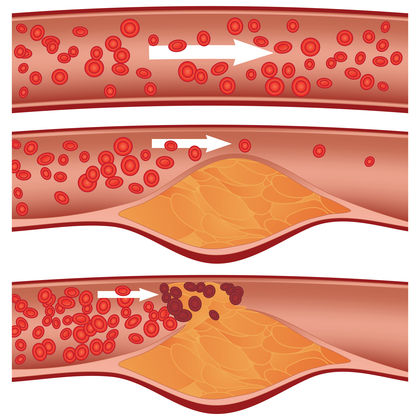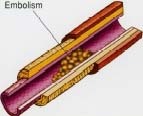Embolism

An embolism (EM-bo-liz-um) is a blockage in the bloodstream, caused by a blood clot, air bubble, fatty tissue, or other substance that plugs a blood vessel.
KEYWORDS
for searching the Internet and other reference sources
Circulatory system
Coagulation
The body's circulatory system is like a huge network of small roads and large interstate highways. It is important that blood continuously flow through the body to carry nutrients, oxygen, and other substances to cells and organs. But like a road, sometimes a part of the circulatory system can become blocked by an accident.
What Is an Embolism?
An embolism is a blockage that plugs up an artery in the body and slows or even stops blood flow to the area of the body supplied by the artery. Many substances can cause blockages. Usually, the embolus (EM-bo-lus) is something small that has broken free from another part of the body and has traveled through the bloodstream until it gets jammed in a blood vessel that is too narrow for it to pass freely.
Emboli (EM-bo-ly; plural of embolus) are dangerous. They may cause death if they block a major artery, such as the large pulmonary artery that runs through the lungs. They also may cause tissue to die if they prevent blood flow to the area. Emboli are sometimes called "accidents waiting to happen."

How Do Emboli Happen?
The most common type of embolism results from the clotting * of blood. When blood clots form inside veins, which is a process called thrombosis * , they may break free and travel to the pulmonary artery. The pulmonary artery carries blood from the right side of the heart into the lungs. In the lungs, blood disposes of carbon dioxide and picks up more oxygen. When blood clots get stuck in the pulmonary artery, they prevent blood from picking up oxygen. This is a medical emergency that causes symptoms similar to a heart attack.
Other substances may cause embolism, for example:
- Bubbles. This sometimes occurs in underwater divers as they ascend, and as the compressed nitrogen bubbles out of solution. This is called "the bends." It also can happen during injections of fluids or medications into veins or arteries, which is one reason why doctors and nurses squeeze the air out of needles before injecting patients.
- Tumors * . These may grow and block blood flow, or a piece of a tumor may break off into the bloodstream and get caught in another part of the body.
- Fat. This occurs when fat breaks off in an area of the body. For example, after a serious injury occurs to a body part like the liver, fat may break off and travel through the bloodstream.
- Bone fragments. A bone chip from a broken arm or leg may become lodged in an artery.
The embolism may occur in any artery, but often occurs in the pulmonary arteries. This is because all the blood returning to the heart from the body is pumped through the pulmonary arterial system first.
What Are the Signs and Symptoms of Embolism?
Symptoms of a pulmonary embolism include chest pain that can feel worse when breathing deeply; shortness of breath; coughing, which sometimes results in blood coming up from the lungs; dizziness; anxiety * ; sweating; and rapid breathing and heartbeat.
These symptoms are similar to those of a heart attack, and some symptoms even resemble those of an anxiety attack. But sometimes embolism does not cause any symptoms at all.
* clotting is a process in which blood changes into a jellylike mass that stops the flow of blood.
* thrombosis is the formation or development of a blood clot or thrombus.
* tumor usually refers to an abnormal growth of body tissue that has no physiologic purpose and is not an inflammation. Tumors may or may not be cancerous.
* anxiety may be experienced as a troubled feeling, a sense of dread, fear of the future, or distress over a possible threat to a person's physical or mental well-being.
* CT scans or CAT scans are the short form for computerized axial tomography, which uses computers to view structures inside the body.
How Do Doctors Diagnose and Treat Embolism?
Embolism is often difficult for doctors to diagnose. Doctors may use an x-ray, a CT scan * , or a lung scan to check for the embolism. Sometimes dye is injected into the person to make it easier to see the embolism on the x-ray or scan.
Pulmonary emboli develop in as many as 500,000 Americans each year, and up to 10 percent die within the first hour. With treatment, many are saved and lead normal lives. Doctors may use drugs that dissolve the embolism and prevent others from forming. Exercise, weight loss if needed, and a proper diet can help prevent emboli from forming.
See also
Bends
Clotting
Phlebitis
Thrombosis
Resource
The U.S. National Heart, Lung, and Blood Institute posts a fact sheet
about pulmonary embolism at its website.
http://www.nhlbi.nih.gov/nhlbi/infcntr/topics/pulemb.htm
Comment about this article, ask questions, or add new information about this topic: